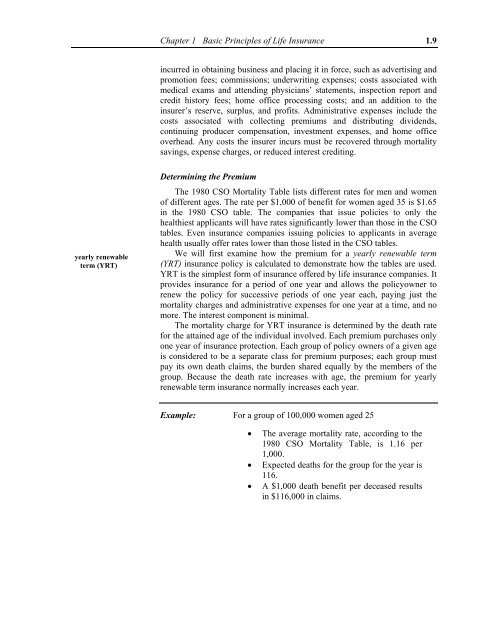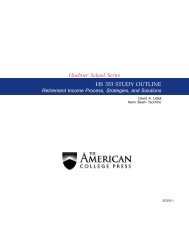Basic Principles of Life Insurance - The American College
Basic Principles of Life Insurance - The American College
Basic Principles of Life Insurance - The American College
You also want an ePaper? Increase the reach of your titles
YUMPU automatically turns print PDFs into web optimized ePapers that Google loves.
Chapter 1 <strong>Basic</strong> <strong>Principles</strong> <strong>of</strong> <strong>Life</strong> <strong>Insurance</strong> 1.9<br />
incurred in obtaining business and placing it in force, such as advertising and<br />
promotion fees; commissions; underwriting expenses; costs associated with<br />
medical exams and attending physicians’ statements, inspection report and<br />
credit history fees; home <strong>of</strong>fice processing costs; and an addition to the<br />
insurer’s reserve, surplus, and pr<strong>of</strong>its. Administrative expenses include the<br />
costs associated with collecting premiums and distributing dividends,<br />
continuing producer compensation, investment expenses, and home <strong>of</strong>fice<br />
overhead. Any costs the insurer incurs must be recovered through mortality<br />
savings, expense charges, or reduced interest crediting.<br />
yearly renewable<br />
term (YRT)<br />
Determining the Premium<br />
<strong>The</strong> 1980 CSO Mortality Table lists different rates for men and women<br />
<strong>of</strong> different ages. <strong>The</strong> rate per $1,000 <strong>of</strong> benefit for women aged 35 is $1.65<br />
in the 1980 CSO table. <strong>The</strong> companies that issue policies to only the<br />
healthiest applicants will have rates significantly lower than those in the CSO<br />
tables. Even insurance companies issuing policies to applicants in average<br />
health usually <strong>of</strong>fer rates lower than those listed in the CSO tables.<br />
We will first examine how the premium for a yearly renewable term<br />
(YRT) insurance policy is calculated to demonstrate how the tables are used.<br />
YRT is the simplest form <strong>of</strong> insurance <strong>of</strong>fered by life insurance companies. It<br />
provides insurance for a period <strong>of</strong> one year and allows the policyowner to<br />
renew the policy for successive periods <strong>of</strong> one year each, paying just the<br />
mortality charges and administrative expenses for one year at a time, and no<br />
more. <strong>The</strong> interest component is minimal.<br />
<strong>The</strong> mortality charge for YRT insurance is determined by the death rate<br />
for the attained age <strong>of</strong> the individual involved. Each premium purchases only<br />
one year <strong>of</strong> insurance protection. Each group <strong>of</strong> policy owners <strong>of</strong> a given age<br />
is considered to be a separate class for premium purposes; each group must<br />
pay its own death claims, the burden shared equally by the members <strong>of</strong> the<br />
group. Because the death rate increases with age, the premium for yearly<br />
renewable term insurance normally increases each year.<br />
Example: For a group <strong>of</strong> 100,000 women aged 25<br />
• <strong>The</strong> average mortality rate, according to the<br />
1980 CSO Mortality Table, is 1.16 per<br />
1,000.<br />
• Expected deaths for the group for the year is<br />
116.<br />
• A $1,000 death benefit per deceased results<br />
in $116,000 in claims.
















